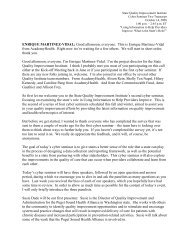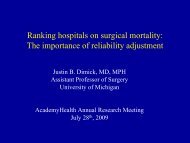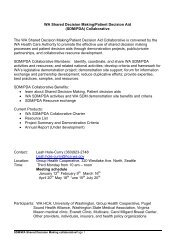Ohio Health Quality Improvement Plan
Ohio Health Quality Improvement Plan
Ohio Health Quality Improvement Plan
You also want an ePaper? Increase the reach of your titles
YUMPU automatically turns print PDFs into web optimized ePapers that Google loves.
Appendix IV — Co m m e n t s f r o mStatewide Or g a n iz a t io n si.ii.I work with a number of organizations that could assistin the implementation of the plan; those include thepublic schools directly, and the School Employees<strong>Health</strong> Care Board, School Employees RetirementSystem of <strong>Ohio</strong> (SERS), the State Teachers RetirementSystem (STRS) and the State Employment RelationsBoard (SERB) indirectly.The organization that I work for, the <strong>Ohio</strong> EducationAssociation, has been working for over a decadeto develop operational standards for health planadministration and evaluation to make up for the lackof such regulation in the school market. Our challengeis getting health plans and school organizations(schools and their health plan purchasing consortia) todevelop employee health risk management plans thatcan support healthy lifestyle choices and provide stressreduction opportunities.iii. The top priority should be to develop supply- anddemand-oriented solution sets in order to counterthe existing health system incentives that providepatients and providers with confusing and sometimesinappropriate behavioral signals for medical serviceoveruse, underuse and misuse.Having worked on the planning committee in preventionfor the HQII effort, I was gratified to find the importancethat ‘informed and activated patients and individuals’ hasfound in the proposed <strong>Plan</strong>. I would like to offer severalobservations and recommendations to improve that sectionof the <strong>Plan</strong>; I did not feel qualified to answer your questions(iv) and (v), nor to comment on the other sections in the<strong>Plan</strong>.The Gruman paper that is referenced on page 18 of the <strong>Plan</strong>lays out the issues involved in patient engagement quitewell. However, the <strong>Plan</strong> re-names the concept ‘activation’,and does not take advantage of the comprehensive‘Engagement Behavior Framework’ as a potential metric.I would urge you to revert to the original wording in orderto facilitate clarity among researchers and practitioners,and would recommend that you expand your metrics tocreate engagement behavior baselines in a number ofpilot populations. Once completed, the results from thesesmaller populations could be folded into the ‘businesscase’ communications to drive the point home. In a similarmanner, other researchers are using small-scale studies toidentify the benefits of behavioral interventions on healthplan prices and individual health; see, for example, DeeEdington’s latest publication available from the Universityof Michigan <strong>Health</strong> Management Research Center (HMRC)(http://www.hmrc.umich.edu/).Again, thank you for the opportunity to provide feedback. Iremain more than willing to assist in the effort.<strong>Ohio</strong> Hospital Association<strong>Ohio</strong> Hospital Association (OHA) appreciates theopportunity to be part of the Implementation Team of theState <strong>Quality</strong> <strong>Improvement</strong> Initiative, and supports thevision and principles articulated in the <strong>Ohio</strong> <strong>Health</strong> <strong>Quality</strong><strong>Improvement</strong> <strong>Plan</strong>. OHA represents 178 hospitals andhealth systems throughout <strong>Ohio</strong>. Governed by a 21-memberBoard of Trustees, the association helps its members meetthe health care needs of their communities.The collaborative transformational strategies that comprisethe core of the <strong>Ohio</strong> <strong>Health</strong> <strong>Quality</strong> <strong>Improvement</strong> <strong>Plan</strong>intersect with OHA’s sphere of interest at varying levels.In general, we support each strategy, within the context ofthe association’s own goals and principles for health carereform. In addition to supporting the objectives of thestate implementation plan, OHA also has several qualityinitiatives:• The <strong>Ohio</strong> Patient Safety Institute (OPSI), anorganization founded by OHA, the <strong>Ohio</strong> State MedicalAssociation and the <strong>Ohio</strong> Osteopathic Associationin 2000 to improve patient safety in <strong>Ohio</strong>. OPSIfocuses on strengthening and promoting policiesand principles to improve patient safety, identifyingstrategies to enhance patient safety in <strong>Ohio</strong> health-careorganizations, identifying barriers to implementationof strategies for improving patient safety anddeveloping strategies that overcome these barriers,promoting identification and dissemination of reliablepatient safety information to the public and providercommunities, and improving patient safety for all<strong>Ohio</strong>ans.• The OHA <strong>Quality</strong> Institute, created in 2008, withthe goal of driving transformational change in areas ofquality and safety in <strong>Ohio</strong> hospitals and to affiliatedproviders. The Institute includes OHA qualityimprovement collaboratives in Dayton (established in1999), Cincinnati (‘05), Columbus (‘08), as well as a39










